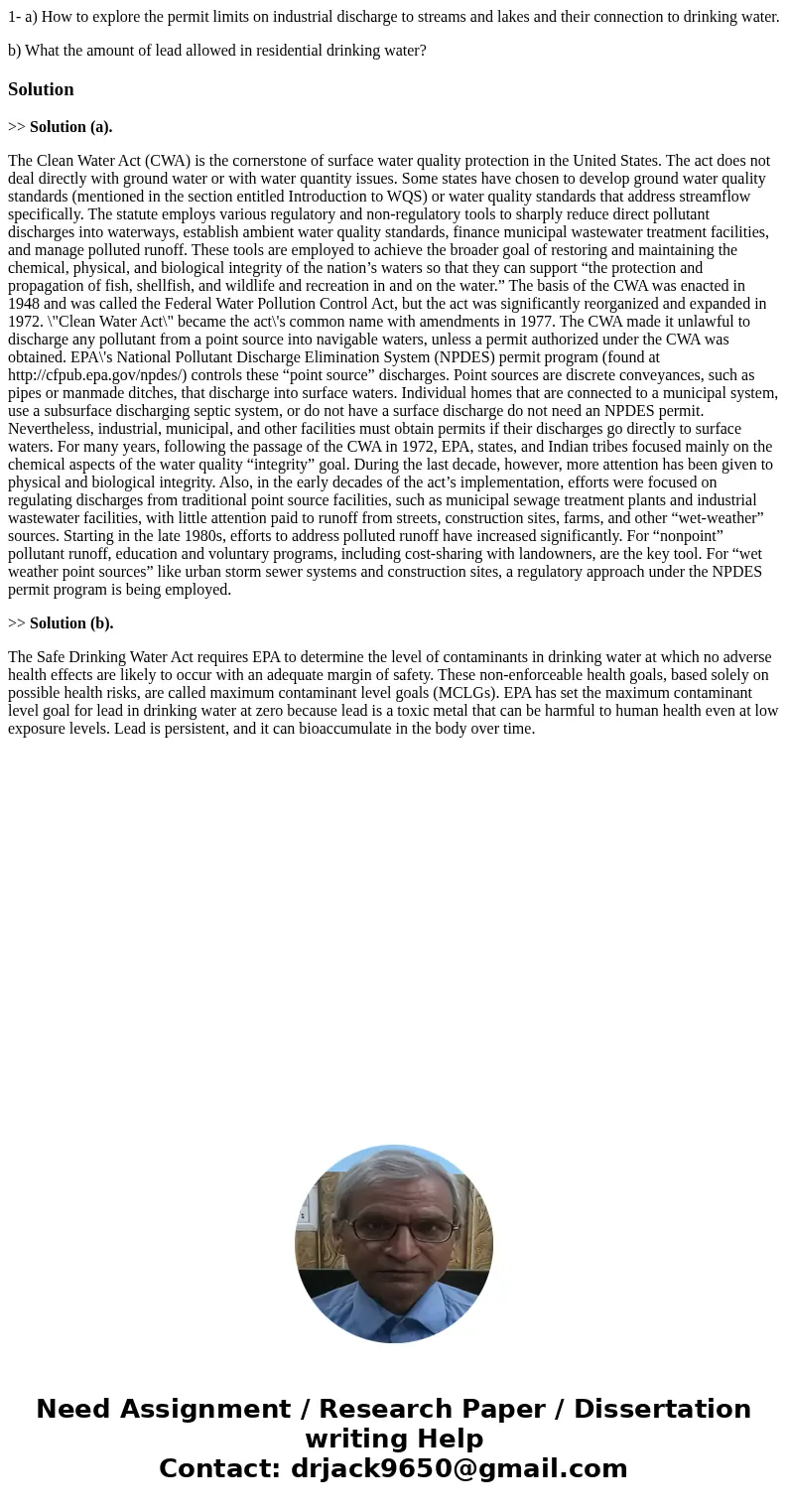1 a How to explore the permit limits on industrial discharge
1- a) How to explore the permit limits on industrial discharge to streams and lakes and their connection to drinking water.
b) What the amount of lead allowed in residential drinking water?
Solution
>> Solution (a).
The Clean Water Act (CWA) is the cornerstone of surface water quality protection in the United States. The act does not deal directly with ground water or with water quantity issues. Some states have chosen to develop ground water quality standards (mentioned in the section entitled Introduction to WQS) or water quality standards that address streamflow specifically. The statute employs various regulatory and non-regulatory tools to sharply reduce direct pollutant discharges into waterways, establish ambient water quality standards, finance municipal wastewater treatment facilities, and manage polluted runoff. These tools are employed to achieve the broader goal of restoring and maintaining the chemical, physical, and biological integrity of the nation’s waters so that they can support “the protection and propagation of fish, shellfish, and wildlife and recreation in and on the water.” The basis of the CWA was enacted in 1948 and was called the Federal Water Pollution Control Act, but the act was significantly reorganized and expanded in 1972. \"Clean Water Act\" became the act\'s common name with amendments in 1977. The CWA made it unlawful to discharge any pollutant from a point source into navigable waters, unless a permit authorized under the CWA was obtained. EPA\'s National Pollutant Discharge Elimination System (NPDES) permit program (found at http://cfpub.epa.gov/npdes/) controls these “point source” discharges. Point sources are discrete conveyances, such as pipes or manmade ditches, that discharge into surface waters. Individual homes that are connected to a municipal system, use a subsurface discharging septic system, or do not have a surface discharge do not need an NPDES permit. Nevertheless, industrial, municipal, and other facilities must obtain permits if their discharges go directly to surface waters. For many years, following the passage of the CWA in 1972, EPA, states, and Indian tribes focused mainly on the chemical aspects of the water quality “integrity” goal. During the last decade, however, more attention has been given to physical and biological integrity. Also, in the early decades of the act’s implementation, efforts were focused on regulating discharges from traditional point source facilities, such as municipal sewage treatment plants and industrial wastewater facilities, with little attention paid to runoff from streets, construction sites, farms, and other “wet-weather” sources. Starting in the late 1980s, efforts to address polluted runoff have increased significantly. For “nonpoint” pollutant runoff, education and voluntary programs, including cost-sharing with landowners, are the key tool. For “wet weather point sources” like urban storm sewer systems and construction sites, a regulatory approach under the NPDES permit program is being employed.
>> Solution (b).
The Safe Drinking Water Act requires EPA to determine the level of contaminants in drinking water at which no adverse health effects are likely to occur with an adequate margin of safety. These non-enforceable health goals, based solely on possible health risks, are called maximum contaminant level goals (MCLGs). EPA has set the maximum contaminant level goal for lead in drinking water at zero because lead is a toxic metal that can be harmful to human health even at low exposure levels. Lead is persistent, and it can bioaccumulate in the body over time.

 Homework Sourse
Homework Sourse